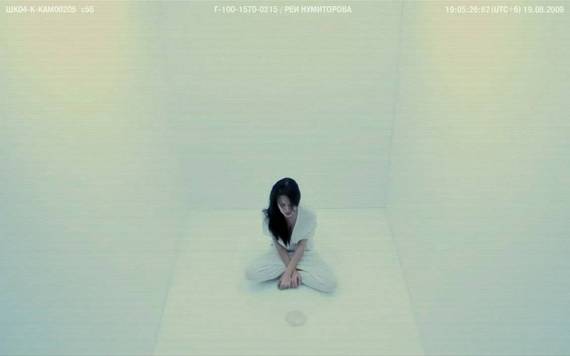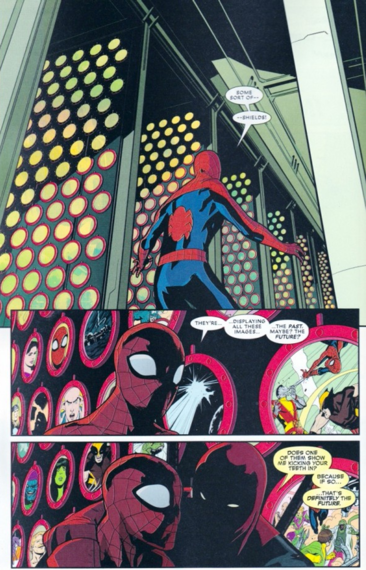Metamodernism is the dominant cultural philosophy of the Internet Age. The term was coined in 1975 by American professor Mas'ud Zavarzadeh, and has been in irregular usage since then. In the past few years, I and others have argued that metamodern philosophy is the best means of understanding the dizzying phenomena associated with network culture. This ongoing "Month in Metamodernism" column offers numerous examples of the metamodern using links and multimedia. Feel free to comment below on anything you see here. What do you make of it?
For some basics about metamodern philosophy, see here and here. Additional articles on metamodernism can be found at this link.
Per usual, a major hat-tip to the amazing io9 for several of these news stories.
Junko Junsai (Alternate Reality Game).
Alternate Reality Games (ARGs) -- sometimes called "pervasive games" or "transmedia stories"--are metamodern. By combining digital play elements and "real-world" tasks, ARGs blur the line between what is real and what is not. But what happens when an ARG becomes so complex and mysterious and seemingly unstructured that you can't even tell if you're playing a game anymore? And what if the "gameplay" involves somewhat frightening forces (and behaviors) that might actually exist in our world and have real-time consequences? Junko Junsai is not just the ultimate ARG but also the ultimate exemplar of metamodern philosophy in ARGs. It takes a very real fear of our all-too-real world -- terrorism -- and then creates a scenario so open-ended that many who engaged with it still don't know if what they were doing was part of an actual terrorist conspiracy or not. Scary stuff, but instructive for metamodern scholars trying to understand what gaming (in the broadest sense) looks like in the age of metamodernism. Read more about the incredible story of Junko Junsai here.
New Horizons, "Pluto Exploration Mission" (Promotional Video).
In one of the most inspiring videos you'll ever see, New Horizons appeals to our common humanity in support of its Pluto exploration mission. What's metamodern here is the use of the term "we" to erase -- optimistically, if not realistically -- the divisions between nations that have marked space exploration thus far. The idea that "we" are exploring space is a new metanarrative which, while it runs afoul of the facts, adds an air of optimism, collaboration, and dialogue -- all metamodern staples -- to an endeavor with universal import but (thus far) input from only a handful of nations.
The Empire Strikes Back, Secret Cinema (Pop-Up Live Theater).
Now playing "at a secret location in the heart of London": The Empire Strikes Back, a Secret Cinema reenactment of major scenes from the celebrated film trilogy. The concept behind Secret Cinema is that you pay to actually "be in" the movie. This sort of "immersive entertainment" is not just metamodern but represents (broadly) the wave of the future: as home-based technologies do more and more to entertain us, commercial enterprises will have to find new ways to lure us out of our homes and into public spaces. The best way to do that? Offer "experiences" (as opposed to passive entertainment) that so juxtapose Life and Art that they can't be replicated at home. Think Epcot Center's take on traveling, but on a much wider scale. "Star Wars Live" is a sign that live cinema is becoming more than just a nerdster phenomenon. For additional information, see this video.
"Fallout 3: Kill Everything," Many a True Nerd (Gameplay Videos).
"Gamebreaking" is metamodern. When you intentionally play a video game "wrong"--following your own rules of play in a way that causes the game to malfunction -- you are writing your own narrative atop the one that's been sold to you, simultaneously acknowledging and living with/within both. That's what happened to the gamer who intentionally killed more than 3,000 people in Fallout 3, including many the game did not want him to kill and was not prepared to lose from its narrative. What resulted from this gamebreaking was a new narrative, with new characters, encounters, and storylines. Calling the narrative "Fallout 3: Kill Everything," the gamer known as "Many a True Nerd" began by killing his in-game "mother" and proceeded to kill (or, where that was impossible, beat into permanent unconsciousness) every human being in the entirely of Fallout 3 (a total of 3,012 persons). Upsetting? Yes. But philosophically, it offers metamodernists a lot to chew on. A broken system doesn't disappear, after all; it merely exists alongside any new one that's developed until the two are synthesized in a format few could ever anticipate.
"Bridge," Just for Men (Commercial).
Commercials' "winks" are becoming harder and harder to spot, a sign that we're moving toward a metamodern stage in advertising in which sincerity and irony become impossible to interpret. In the Just for Men commercial above, it's easy to miss the fact -- if you're seeing the spot for the first time and haven't encountered it in the context of an article on metamodernism -- that the commercial is entirely self-mocking. We're so accustomed to seeing hair coloring products for men marketed as manly that when a commercial points out the ridiculousness of that trope we almost miss it. To be clear: the man in this ad is fixing a bridge with duct tape.
A similar phenomenon, which will be discussed next month, is "referential drift" -- when a commercial (e.g., the recent State Farm spot featuring SNL's "Coneheads") riffs off a nearly identical predecessor from the same company (in this case, a State Farm ad with a plotline featuring human beings, whose dialogue the eerily repetitive "Coneheads" spot both repeats and deviates from).
Fall Collection, Prada (Clothing Line).
Italian luxury fashion house Prada says its new collection is "an elegant, ironic ode to metamodern femininity". The thinking here, presumably, is that the collection, pictured above, permits women to aggressively express their individuality and independence by dressing as women dressed during a time of widespread misogyny and institutionalized sexism (the 1950s and 1960s). In a sense, these "retro"-seeming looks emphasize just how far we have to go in the present to achieve full gender equality, while also "taking back" history in a way Prada likely considers liberating. Should we consider this line, as Prada invites us to, "ironic"? Sure, but it's in service of sincere motivations and an earnest desire to recover and even supersede the past on its own turf.
"The Coup in Burundi", BBC (News Coverage).
SoundCloud, a music-sharing app, is now being used by journalists to report on a coup in Burundi. Repurposing mass technology to achieve elective, highly directed, clearly emotionalized ends is a common phenomenon in the age of metamodernism.
WordPalette (iPhone app).
A new iPhone app, WordPalette, allows you to use metamodern experimental writing techniques like remixing to escape the scourge of writer's block and produce amazing new texts -- partly original, partly borrowed. Definitely worth checking out! You can find out more about the app on its webpage.
"Cheeks", Zak Arctander (Photograph).
Metamodern creative techniques are controversial in part because they often involve combining our own creativity with that of others -- simultaneously appropriating and adding substantially to an existing artwork as a way of modeling how collaboration works in a networked world where almost everyone is anonymous and almost everybody is (paradoxically) heavily influenced by strangers. The problem is that if a critic doesn't like how you've augmented the work, they'll say you've merely stolen it; and if the critic thinks you've augmented the wrong person's work, they accuse you of having selected your source material out of hatred rather than a sincere interest in the original art. That's what happened recently when Jezebel caught wind of the fact that Zak Arctander had used a queer feminist photo project as part of a new, metamodernist "augmented reality" experiment (photo above).
Arctander was accused, by implication, of being a predator and a bigot, as has become all too common in instances in which dialectical postmodernists are critiquing metamodern art. Fortunately or unfortunately, however, this is the art world of the future -- passive collaborations across time and distance, with the measure of an artist often being as much how s/he has transformed something that already exists as how or whether s/he has created something from nothing. In the article linked to above, note the derisive (and clearly irrelevant) references to Yale and Arctander's MFA degree, as well as the repeated but unsubstantiated claim that Arctander appropriated the work he did because he was targeting queer artwork for theft -- not because he admired it and wanted to use experimental compositional techniques to build upon it.
Joe Gibbons (Performance Art).
Former MIT professor and performance artist Joe Gibbons robs banks as part of his ongoing art practice -- a more extreme (and absolutely illegal) extension of Marina Abramovic's comparatively tame juxtapositions of Life and Art. Now that he's been caught, you can read more about Gibbons here. As was the case when metamodernist Shia LaBeouf used his new-found interest in metamodernism to inflect his serial plagiarisms, armchair commentators have come out of the woodwork in droves to say that Gibbons never was an artist -- only a criminal. Even a cursory look at his history of artworks proves otherwise, though that's no legal justification for what he did.
"Before and After," Sophie Kay (Photographs).
Metamodern philosophy emphasizes the ways in which the indistinguishability of reality and unreality offers us hope much more than it does despair. Personal trainer Sophie Kay has permanently given the lie to "before and after" photos by showing how photos taken sequentially can portray entirely different realities. The aim of the photo series appears to be not a deconstruction of the diet and exercise industries but an encouragement of viewers to construct their own idiosyncratic metanarratives (rather than buying into, for instance, the tired, dialectical "hero" narrative implied by before-and-after photography). "I trained as a personal trainer to help other people become the best they can be, not the best other people can be," says Kay in this article. But Kay is also doing us another service: by emphasizing how silly fitness selfies are, she's really encouraging us to think more deeply about how both "before" and "after" photos are always-already (as academics like to say) us. Using technology's ability to artificially collapse time to emphasize that time cannot, in fact, be collapsed feels like an optimistic rather than ironic strike against the fears induced by network culture.
Deadpool (Comic Book Character).
Comic books have always been well ahead of their time -- vaguely metamodern in an era of hardcore postmodernism -- because of their tendency to be simultaneously reverent and indifferent to narrative. Comic book collectors are obsessive about what's "canon" and what isn't, and yet they know, too, that the canon is so often re- and over-written that it doesn't actually mean anything. The comic book character Deadpool has for years been "meta-" in the sense that he breaks the fourth wall regularly and acknowledges that he's in a comic book. Deadpool's recent trips into past comic books, however, amp up the metamodern quotient by making the question of "canon" moot once and for all. After all, if canon-destruction is something that happens "in-world" -- something one comic book character can do to another within the context of a single fictional reality -- the very idea of canon is at once entrenched and undercut (just the sort of exploratory juxtaposition of opposites metamodernism loves). With these recent issues, Marvel has emphasized that comic-book reality is fundamentally a metamodern reality -- one in which the future, past, and alternate futures and pasts are all happening simultaneously and atop one another. Under these circumstances, privileging one past/future over another becomes an impossible (and finally unnecessary) task.
"Peeno Noir," Tituss Burgess; "Jaqen H'ghar," Practical Folks (Songs).
"Peeno Noir: An Ode to the Black Penis" is a song from Unbreakable Kimmy Schmidt that a) only makes sense in the context of that show, and thus b) is meaningless to anyone who doesn't watch the show. But what if you watch that show and also Game of Thrones? Well, apparently that enables you to take the melody from one obscure pop-culture reference ("Peeno Noir") and attach it to another one (the mystery of "Jaqen H'ghar" in Game of Thrones) to create cross-over art so gleefully obscure that it's hard to turn away from (or forget) even if you don't know why on Earth it exists.
Rachel Dolezal (Metamodern Human).
According to CNN contributor Camille Gear Rich, Rachel Dolezal -- the highly placed NAACP volunteer from Washington state who turned out to be white -- has "a right to be black." This caused metamodernists to sit up and take even more notice of the strange story of Rachel Dolezal than they already were -- not because metamodernism is specifically identified with the term "post-racial" (it's not), but because metamodern philosophy is invested in overlapping subjectivities, especially when they seem to defy "objective" reality. After all, seminal metamodernist Mas'ud Zavarzadeh was keen to distinguish reality from actuality in his historic 1975 essay "The Apocalyptic Fact and the Eclipse of Fiction in Recent American Prose Narratives."
Dolezal self-identifies as black, is visually identifiable as a lighter-skinned African-American (and has even been adjudicated a minority for legal purposes, as she was the victim of a prosecuted hate crime); has spent much of her adult life working for racial justice with the NAACP in Spokane; and yet a) appears to be biologically Caucasian and b) appears to have lied to her employer and the communities she works in about her "biological" racial identity. There are no easy narratives to be found here: Dolezal lied to her employer, deceived co-workers, and claimed a racial history not her own; on the other hand, she voluntarily did (apparently fantastic) work for the NAACP and lived the life of an African-American for many, many years -- including, her biography shows, facing substantial discrimination because of her "race." Arguments that she could turn back into a Caucasian whenever she wanted to fall somewhat flat in this instance, as while that would be true if Dolezal had done all this on a lark or as a sociology experiment, the better analogy appears to be (though it is a very, very imperfect analogy) to a pre-op transgendered female being told that her experiences with sexism are meaningless because she could always become a male again. Well, no, not if we accept that there is an earnest psychological and perhaps even biological imperative at work. But is that the case with Dolezal, and can it ever be with race?
I don't know, honestly, and I think there will have to be much more consideration of all this before any intelligent conclusions are reached. What we know at the moment is that the case of Rachel Dolezal raises questions of subjective identity that dialectical postmodernism doesn't seem well-prepared to address. Dave Chappelle recently noted that in the well-known "racial draft [of multi-racial celebrities]" he (satirically) runs on his comedy program, "black people" would "definitely" draft Rachel Dolezal because a) she worked her butt off voluntarily for the NAACP and was good at her job, and b) she elected to live a life (without telling anyone) in which she suffered some (perhaps even most) of the harms African-Americans continue to suffer regularly in this country. Again, I don't know what we do with that sort of data, but it does raise questions of affect-versus-effect, multiple subjectivities, personal versus local metanarratives, and what "authenticity" really means in a post-postmodern world.
Steven Universe (Animated Television Program).
Steven Universe is a new animated program on The Cartoon Network that reverses and juxtaposes gender/racial roles and identities, and imagines a community in which such demographic distinctions almost seem not to exist. It's uncanny and metamodern the way this show, developed and written by Rebecca Sugar, is both achingly earnest and yet aware -- in the subtlest of ways -- of its subversiveness. You have to watch it to understand. Here's a glowing review of the show on io9.
Above, the song "Do It for Her" implicitly emphasizes the metamodern juxtapositions of Steven Universe by depicting a black female knight being assigned to protect a white male (as though he were a princess in distress; indeed, in most episodes Steven displays traits more commonly associated, rightly or wrongly, with young girls rather than young boys). And yet this inversion of an aged trope is noted only in the lyrical self-corrections deftly employed by Pearl, the mentor for both Steven and Connie.
"Futuristic Weapons That Will Change Modern Warfare", Teqzy (News).
Invisibility cloaks now exist.
It's not that futuristic things are somehow automatically "metamodern," it's that the status of fantasy and science fiction as "escapist" (a common postmodern bugbear) is terminally injured when every day we learn of an "impossible" sci-fi-fantasy setpiece that is actually possible. Harry Potter's Invisibility Cloak is little different from the one described in this article on ten new developments in modern warfare. Others include massive lasers, weaponized animals, self-guiding bullets, guns that shoot around corners, and something called The Dread Gun that looks like a flying saucer with a pistol grip. How do we read "fiction" in a world in which "fiction" is simply a speculation about the future as likely to be accurate as nonfiction is in describing the present -- and sometimes much more so? Scholars have long read sci-fi for its themes and rhetorical structures; what if they began treating it as "speculative nonfiction," a paradoxical literary genre developed by American professor Nathaniel Minton while he was studying at the Iowa Writers' Workshop in 2007?
Beast Quest (Book and iPhone App).
Can book-inspired iPhone apps lead to increased sales of the books they're based on, because some readers are encountering the book first as gamers? Yes, as Beast Quest makes clear. Based on the popular children's book series, the app version of Beast Quest not only is adding to the popularity of the book but helps us see how new technologies might actually (paradoxically) drive us back to older ones -- without tossing out our fondness for new technology. In other words, book and video game can happily coexist, because the former is always-already, now, "post-internet"; they need not engage one another across a postmodern dialectic. Read more here and here.
South Park: The Fractured But Whole (Video Game).
I've written before about how and why Trey Parker and Matt Stone's South Park RPG series is metamodern, so I won't belabor that here. But now there's a new edition of the series forthcoming (metamodern gamers take note)! South Park: The Fractured But Whole, another RPG about real life being an RPG, promises more of what we got from South Park: The Stick of Truth. Of course, in broader terms South Park has always been a little metamodern: it depicts kids earnestly being kids amidst a world that renders all their actions automatically ironic and absurd. Those who deem the kids of South Park habitually cynical forget how often characters like Stan, Butters, and Kyle are themselves painfully earnest and naive -- until, that is, the inevitable rude awakening from without.
"Heutagogical Metamodernist Paradox in Education: Self-Regulated Courses with Customizable Modalities" (Conference Paper Proposal).
Finally, courtesy of Edugeek Journal, we get a little taste of how metamodernism is transforming curriculum development at all levels of education. We've heard whispers of this here and there, but in the story of a rejected academic conference paper we get both the substance and (sadly) an indication of how far our educational establishment has to go in terms of embracing metamodern philosophy in the classroom.
[Scroll down at this link for more essays on metamodernism.]
Seth Abramson is an Assistant Professor of English at University of New Hampshire and the Series Co-Editor of Best American Experimental Writing, whose next edition will be published by Wesleyan University Press in late 2015. His most recent book of metamodern verse is Metamericana (BlazeVOX, 2015).









